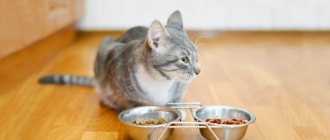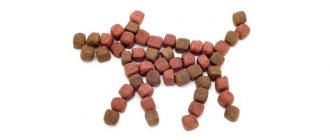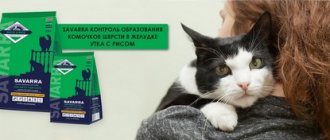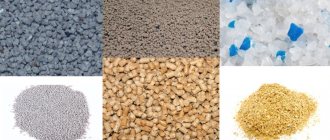01.01.1970
For the health and normal development, activity and energy of your pet, it is necessary to choose a diet for it that is as close as possible to what wild cats eat in their natural environment. The Maine Coon's diet should include poultry and rabbit meat, supplemented with veal and lamb, which is beneficial for kittens and adult cats. To provide your pet with a balanced diet, you can choose and buy dry food or canned food for Maine Coons.
Rating of food for Maine Coons
To determine the best food, we carried out a large amount of work: analyzed dozens of nominees, studied the composition, took into account customer reviews, as well as veterinarians’ assessments. Additionally, the selection took into account the following criteria:
- Availability of useful supplements;
- Prevention of stones and hairballs;
- Croquette size;
- Degree of digestibility;
- How much does it improve digestion?
- Percentage of natural ingredients;
- Class – economy, premium, super-premium;
- Packaging volume;
- Price.
For convenience, all food has been divided into two classes: super-premium and premium.
The best flea drops for cats
The best premium food for Maine Coons
Premium food has a natural composition and many additional substances for the sensitive digestive system. They are full of vitamins, minerals, proteins, do not cause side effects, and are easy to digest. The price for such options is lower than that of the previous class. The granules are small, easy to chew, and do not clog the stomach. The rating includes 3 nominees with a good composition.
Purina Pro Plan Delicate
The pate is created for a sensitive digestive system, developed on the basis of dietary meat. The composition is balanced, rich in various nutrients, has many vitamins, a complex of minerals, antioxidants, and fatty acids. Natural substances are sufficient to maintain the health of cats, to improve metabolic processes, and to prevent the appearance of plaque on teeth or tartar deposits. It also contains vitamin D3, zinc, copper, iron, iodine, selenium, and crude fiber.
Advantages
- Balanced composition;
- Convenient packaging;
- Pleasant taste and aroma;
- Strengthens teeth;
- Protection against urolithiasis.
Flaws
- Contains food flavorings.
To eliminate the risk of side effects and allergies, it is necessary to conduct a component tolerance test. To do this, it is enough to gradually introduce complementary foods into your pet’s diet, observing its activity, stool consistency, and general condition.
Leonardo Quality Selection
In production, we use high-quality by-products and raw materials that do not contain preservatives, soy components, flavors, or dyes. Wet food consists of 90% poultry and 10% liver. The recommended daily portion is 200-400 grams, designed for a pet’s weight up to 3-5 kg. A can of canned food is designed for one day, this is enough to fully saturate the pet’s body and enrich it with natural ingredients. The wet consistency does not stick to the teeth, does not dry out the mouth, and does not require constant availability of water.
Advantages
- Vitamins and minerals containing;
- No preservatives;
- Economical consumption;
- No flavorings;
- Doesn't dry out.
Flaws
- High price.
A can of canned food is designed for one day, this is enough to fully saturate the pet’s body and enrich it with natural ingredients.
Bozita with salmon
Dry food with salmon flavor helps improve intestinal function, enriches it with useful components, and has general strengthening properties. A large number of minerals are specially adapted for castrated cats and sterilized cats that need additional care. There are no dyes, preservatives, or GMOs. It improves metabolic processes, strengthens joints, and promotes skin and coat care. Thanks to zinc, biotin and fatty acids, complete hair care is provided, preventing hair loss and the formation of hairballs in the stomach.
Advantages
- Useful components;
- Full saturation;
- Economical consumption;
- Convenient release form;
- Different tastes.
Flaws
- High price.
The food is not suitable for Maine Coon kittens, it can be given from the age of 1 year. The increased content of natural substances improves metabolic processes, increases activity, and activates growth. It is important to follow the prescribed daily dosage to avoid side effects such as bloating or diarrhea.
Menu for kittens
The rules for creating a menu for kittens depend on the age of the animals. At first, pets eat only mother's milk, then they are gradually transferred to adult food.
First month
Until 3-4 weeks, the kitten should eat exclusively mother's milk. If for some reason the cat cannot feed the babies, it is recommended to purchase special substitutes. The most popular products of this type are Beaphar Kitty Milk and Babycat Milk Royal Canin. The proportion of milk sugar in them is minimized, therefore reducing the likelihood of developing individual intolerance and diarrhea.
Substitutes are better than cow's milk due to their adapted composition: the concentration of lactose in them is lower, which makes them safer
It is advisable to dilute the cat's milk replacer with more water than indicated in the instructions. This will help avoid constipation.
As a last resort, feeding with formulas based on cow's milk is allowed. Due to the high proportion of lactose in the product, the kitten may experience diarrhea. If diarrhea occurs, it is important to quickly contact a veterinarian, because as a result of fluid loss, babies quickly become dehydrated.
The universal mixture is prepared from 500 ml of milk, 1 raw egg yolk and 2 tbsp. l. Sahara. To enrich the product with useful substances, you can add 1 tsp. corn oil and the contents of 1-2 capsules of vitamin E. Weak kittens are given a mixture of 100 ml of milk (3.2% fat), 1 chicken yolk and 20 ml of 5% glucose solution. For digestive problems, add the probiotic Vetom 1.1 at the tip of a knife.
The egg in the mixture helps increase the proportion of fats, B vitamins and minerals
In young kittens, the thermoregulation system is not fully developed, so it is important to warm the mixture. At 1 week, the liquid temperature should be +38…+39 °C. In the second week, the mixture is heated to +30…+32 °C. Later the temperature is lowered to +28…+30 °C. By the fourth week, the mixture is heated only to +24…+26 °C.
Diluted milk should be stored in the refrigerator for no more than a day. It is recommended to prepare a new portion before each feeding.
The amount of food and frequency of feedings depend on the age and weight of the kitten.
Table: individual food allowance for Maine Coons
| A week | Amount of food | Schedule and features |
| First | From 1 to 4 days 30 ml per 100 g of weight | In the first 2 days, kittens are fed every 2 hours, including at night. From day 3, the break between night snacks is increased to 3 hours. From day 5, kittens are fed every 4 hours. |
| Second | From 5 to 13 days 38 ml per 100 g of weight | Kittens are fed every 4 hours. From the 15th day it is allowed to introduce complementary foods. At the same time, it is recommended to gradually accustom the animals to bowls and saucers. At first, you can let your pets lap from spoons. |
| Third | From 14 to 24 days 46 ml per 100 g of weight | The frequency of meals is the same. |
| Fourth | From day 24 53 ml per 100 g of weight | Kittens are fed every 4 hours. From 3–4 weeks, other products must be introduced into the menu. |
From 1 to 6 months
Complementary foods are introduced into the diet in order to transition to adult food. Changes must be made gradually. Kittens have very sensitive digestion, so a sudden transition can provoke diarrhea and the development of pancreatitis. You can use baby cottage cheese without additives as your first complementary food. It is allowed to be given every day.
The classic Tema curd is suitable for small kittens: it does not contain additives and has a fairly soft consistency.
Meat is gradually being introduced into the menu. First, the animals are given a staple—separate whole fibers. The size of the first portion should not exceed a pea, then it is gradually increased to the volume of a chicken egg. The meat is given raw, but it is well frozen beforehand. This is necessary to eliminate potential pathogens and parasites. Meat is given every day. Chicken, turkey and beef are suitable for complementary feeding.
Kittens should not be given minced meat. This is due to its texture: there is no fiber in it, so it is more difficult for the predator’s body to digest the delicacy.
You can use oatmeal without additives as complementary foods. It must be liquid, otherwise constipation may develop. Porridge can be cooked with milk. After getting used to meat, once a week you can offer the kittens low-fat sea fish. Cod, capelin, hake and pollock are suitable. 1–2 times a week, animals are given chicken yolk and soft unsalted cheese.
Oatmeal is used as a source of fiber, but it should not be the basis of the diet: it does not contain animal proteins, which are necessary for the final formation of internal organs
Kittens are taught to eat vegetables from childhood. From 3-4 weeks you can give zucchini, broccoli, cauliflower and carrots. Animals rarely eat raw vegetables, so it is recommended to boil the food, chop it with a blender or grater and mix it with meat.
New products are introduced into the menu gradually, 1 every 1–2 days. This is associated not only with the risk of digestive disorders, but also with the likelihood of developing allergies.
Until 6 weeks, complementary foods should have a liquid consistency. Then the pet is gradually transferred to solid food and abandoned cereals. The process should be completed at 3 months, because at this time the change of teeth begins. To form the correct bite, the kitten must chew hard foods. From 6–8 weeks, you can begin to switch your pet from natural food to ready-made wet or dry diets. In the latter case, the granules are first soaked.
The granules must be soaked only in warm water, otherwise the process will take 30–40 minutes
When feeding natural products, the average norm is 150 g of food per 1 kg of kitten weight. In the case of ready-made diets, it is advisable to follow the manufacturer’s recommendations and observe the animal’s physique. Kittens are not able to independently regulate portion sizes, so to prevent overeating, the daily intake is divided into 5-6 parts. After 3 months, kittens can be fed 3-4 times a day.
It is not recommended to give kittens food for adult animals. It contains less fat, calories, vitamins (A, group B, E) and minerals (calcium, magnesium, potassium, etc.), which can lead to improper formation of internal organs and systems. Although I personally gave my kitten the Grandorf holistic food and there were no problems. But this may be due to the versatility of the formula and its proximity to the natural diet.
From 6 months to 1 year
Grown-up kittens are fed the same as at 3–4 months, but are transferred to three meals a day. With a natural menu, 80–85% of the diet should consist of meat products. Kittens require a lot of protein to form muscle fibers. Dishes are not chopped as thoroughly as before. Animals begin to be given harder parts: cartilage, hearts, lungs, etc.
The granules of food for kittens must be round, otherwise the animal will be in pain, which will provoke a refusal to eat.
When eating ready-made diets, the menu in most cases does not change. Manufacturers most often produce products for kittens from 2 to 12 months. Only the portion size is adjusted depending on the weight and build of the pet.
How to choose food for Maine Coons
When choosing food, you need to pay attention to the composition, the ratio of natural substances and additives. Dry food should protect the digestive system from disorders, stop the appearance of pain, heaviness, and diarrhea.
Type of feed
The manufacturer creates two types of food: dry granules and canned food. The granules are created primarily for adult cats over 1 year old, who have a fully formed stomach and a functional digestive system. Granules are available in different sizes, which are selected individually. They do not clog the stomach, are easy to bite, and additionally cleanse teeth of plaque.
Canned food has a soft consistency with pieces of meat or fish, which is easy for small cats to consume. They are easily digested, activate the digestive system, saturate the body with useful components, and promote growth and development. We also recommend taking them for stomach upsets.
Special Needs
Pet food has medicinal properties and is prescribed by a veterinarian to normalize the functioning of the gastrointestinal tract, get rid of hairballs in the intestines, and increase immunity. On each food package, the manufacturer indicates the main goal: balanced nutrition or medicinal properties. Before treating any disease in cats with food, it is advisable to consult a veterinarian to select healthy complementary foods.
Veterinary diet
Many cats cannot tolerate human food and do not receive enough beneficial components. That is why veterinarians prescribe a special diet for pets, which involves consuming a certain type of food. Such granules contain many vitamins, minerals, micro- and macroelements necessary to activate various processes. The diet lasts no more than 1 month and occurs under the supervision of a veterinarian.
Compound
Dry food for pets can be based on meat and seafood. Additionally, the following components are present:
- Vitamins;
- Taurine;
- Fatty acid;
- Amino acids;
- Minerals;
- Micro- and macroelements;
- Cellulose;
- DL-methionine.
The components improve the functioning of the body, strengthen the immune system, help maintain the beauty of the coat, making it clean, smooth and shiny.
Veterinarian recommendations
To normalize digestion and maintain your pet’s health, it is recommended to follow the following recommendations:
- Use stainless steel bowls. Plastic releases toxins into food.
- Watch your drinking regime. The cat should receive 20–40 ml per 1 kg of weight for the normal functioning of the gastrointestinal tract and urinary system.
- Feed on a schedule. Cats get used to a certain regime. It is easier for their body to digest food if they follow a schedule.
- Watch your physique. Manufacturers' recommendations are a guideline, but not exact data. If the general norm is observed, animals with different metabolisms and activities can lose or gain weight.
What is the best food for Maine Coons?
Among all the presented nominees, we have identified the following 4 foods:
- Royal Canin Maine Coon - dry granules for adult cats with vitamins, fatty acids, and other useful components;
- Happy Cat Supreme - food created for spayed and neutered pets, contains a lot of fiber, does not cause side effects;
- Purina Pro Plan Delicate – necessary for the diet to improve the functioning of the cat’s gastrointestinal tract;
- Bozita with salmon is good value for money.
The nominees described in the rating have all the necessary substances for the growth, development and maintenance of important systems in the body of a pet.
Daily norm
Royal Canin Kitten feed rate in grams per day
| Kitten age | Kitten weight | |||
| 4-5 kg | 6-7 kg | 8-10 kg | ||
| 1-2 months | Royal Canin Babycat 34 | |||
| 3 months | 64 | 78 | 97 | |
| 4 months | 66 | 89 | 105 | |
| 5 months | 71 | 95 | 122 | |
| 6 months | 72 | 98 | 125 | |
| 7-9 months | 70-73 | 100 | 126 | |
| 10-11 months | 70-74 | 90-100 | 100-126 | |
| 12-14 months | 70-75 | 90-100 | 100-126 | |
| 15 months | 70-75 | Royal Canin Maine Coon 31 | ||
Great for cats during pregnancy and lactation
| Pregnant cat | 62-100 | 85-155 | — |
| Nursing cat | No restrictions | ||
It is very important to focus on the daily diet, which is indicated on the packages. Also, don’t forget that Maine Coons are a water-loving breed. Therefore, provide your pet with constant access to clean and fresh water.











